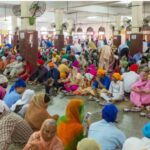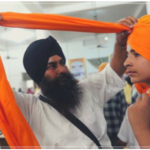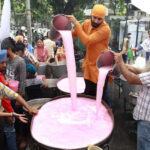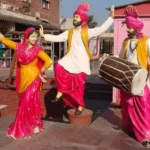Wear out parna is alright when one is at sweet home in an easier mood.
But going out it is essential to dress up proper way.
While out a sikh without turban is not regarded completely dressed, so while going out wear a turban is must for the sikh.
Before ninteenth century, most of the humans including the Sikhs used to wear out dumalla. But after that this fashion changed and individuals began wear out normal turban.
Though various Sikhs even in present timings wear dumalla but is not pretty much common.
Even then it is upto you in what kind of turban you felt quite comfortable.
Wear a normal turban or a dumalla making no difference.
Whereas which is easier to tie? I think both, provided you understand how to wear.
Though normal turban is easier to tie but if you are pretty much trained, dumalla is not tough to tie.
So try both, looking into the mirror, see how you are looking and then decided.
It does not matter! What matters is Why does you wear out a Turban, not how you wear it out, which kind you wear. The sponsoring idea is significant….
We want to look into the religious, cultural, and political contexts to appreciate and understand the multi-layered outlook.
Turban in Sikhism signifies multiple perspectives/values/ideas …
A noticeable symbol against abuse. Sikhs cannot conceal, and during Mughal rule there was a cost on the head of every Sikh… easily identified by a headgear (Turban) – both women and men! It was highly brave to sported out a Turban during those timeline.
A Sikh is duty bound to support others in need and to upholding the Dharma… even at the value of their own existence … so a turban can be easily identify by those seeking aid/help.
A protection during fight, especially when topping with chain-mail and chakra (steel rings).
As a protest against class / caste based abuse – only nobility was permitted to wear out pugrees/turbans … this was yet another stand against differentiation…. in line with Sikh equality ideology.
But, the most significant outlook coming from acknowledging the fact that in Indian Culture or in India… we covered up our heads in presence of elder people…here Sikhs cover up their heads in presence of Almighty!!
In Indian culture turban was a standard dress to protect the head from the sun and protect hair. Sikhism preache out acceptance of Almighty Will unconditionally, & that involves the present of hair. We check out the vedic sages are shown with a top knot and hair… so in Indian culture we would see holy being do kept their hair long. Sikhs are holy being-soldiers (sant-sipahi), hence, Sikhs are commanded not to modify their bodies and cut hair, that is accept their Almighty given form. Hence, Turban supports in managing long hair and keep it clean.
So, it really do not matter how you cover up your hair… what matters is Why you do so!
You do wear any turban that suited you, suits the work you are in motion.
This is purely as per your wish. You do select any type.
Turban and Dumalla can be weared any where & Patka could be wear out casually.
Dumalla/Turban is for a distinctive identity to attendant of Sikhism or Khalsa (A Sikh do becoming Khalsa after he costume up Amrit Dhari).
Some Sikh women also tied a turban who hold AMRIT in their lifetime.
But for those women who are not prepared to holding AMRIT, it is alternative for them to to cover their head with chunni and tie a turban.
And if talking about cute tiny sikh kids they also covered their head but it is again not essential for them to tie a turban as most of them find it tough to grasp turban tying process at earlier age, so they cover their head with a tiny chunk of clothing Known as PATKA.
Turban/Pagg is tie up by Sikh men who have shaggy hair. There are various styles of pagg. Pagg was fundamentally introduced as a format of turban during Maharaja Ranjit Singh’s rule. You do check on YouTube, see which one you love, trying them and whatever fits you best, go for it!
Dumalla is necessary the at first turban. It is now tie up by few of the Amritdhari Gursikhs. The plan behind dumalla is that it is pretty much tight, supportful in warfares and also, it is tie up without hold on one end of the clothing in the mouth, such as in the case of Pagg, which making it sucha. There are again a some styles in dumalla as well, which you do easy way discover videos for.
• Basic Amritsari dumalla/ dumalla
This is the most usual Dhamala dastaar. It consists of:
• one five meter chunk (Navy Blue)
This is the most famous turban among younger Sikhs of a Akhand Kirtani jattha.








